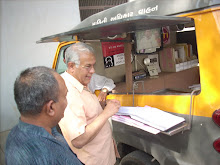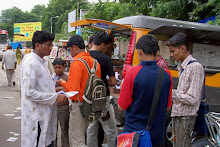COUNTERVIEW:
Ahmedabad: Friday, 16 October 2015.
Fresh facts
have come to light suggesting that, in Gujarat, there has been extremely tardy
progress in the allocation of surplus land to the landless, acquired from big
landlords under the Gujarat Agricultural Land Ceiling Act, 1960. Based on right
to information (RTI) pleas, the district registrar of land records, Junagadh,
has admitted that out of 11 of 16 villages for which information was sought,
"no land survey of surplus has taken place" for the last 24 years,
hence there was no allocation.
In another
instance, in Navsari district, Gujarat government declared that between 2006
and 2008 it had “allocated” land to 7,542 landless beneficiaries, but a year
later, it admitted the land titles were yet been given to 3,616 beneficiaries.
“However, now, on the basis of an RTI reply, we know that things have not
changed even in 2015. The reply that we have received says that there no record
of surveying the land meant for allocation”, says Jignesh Mewani, a Dalit
rights lawyer.
In a recent
article, published in “Dalit Adhikar”
(October 1, 2010), a Gujarati periodical, Mewani says, “Information with
us suggests that the Gujarat government, in all, acquired 1,63,808 acres land
under the Gujarat Agricultural Land Ceiling Act, 1960, and we feel most of it
has been allocated to the landless only on paper. The landless mainly Dalits,
tribals and belonging to the other backward classes (OBCs) haven’t have yet
got actual possession of land.”
Mewani
claims, “Chief beneficiaries of the land-to-the-tiller policy have been upper
caste Patels. About 55,000 Patels were allocated 12 lakh acres of land declared,
mainly in Saurashtra and Kutch regions of Gujarat. But as for Dalit landless
agriculturists, they have received not even 12 inches of land of course, a
very small section, which is very close to the powers-that-be, has gained.”
According to
Mewani, “Let us give a sample of the
Gujarat government’s good governance: We made in all 65 RTI applications
between 2011 and 2015 to find out facts about allocation of just 6,500 acres of
land in different villages. Yet, officials are refusing to give copies of land
titles which may show that land has been actually handed to the beneficiaries.”
Associated
with Jan Sangharsh Manch, a Gujarat-based human rights organization, Mewani
says, “Of the 1,63,808 acres of surplus land, 70,000 acres of land is under
dispute with the revenue tribunal, Gujarat High Court and the Supreme Court.
While this land may not be allocated, there is a need to answer as to why rest
of the land, too, remains unallocated.”
In fact, says
Mewani, there are 15,519 acres of surplus land, on which there is "no
dispute" at all, yet the Gujarat government is “refusing to act”, and the
“ruling BJP, in collusion with the Opposition Congress, is sitting pretty.” He
alleges, “Even Dalit, tribal and OBC legislators are not taking up the cause of
the landless.”
Facts on
Gujarat government’s "indifference" towards allocating surplus land
have come to light amidst a recent amendment Bill to the 1960 land ceiling Act.
The Bill's preamble talks of selling the surplus land lying idle with “any
urban local body” for “public purpose, when the land is situated within the
areas of such local body”, and to “any person, for industrial purpose, or for
the purpose of development thereof, when the land is situated outside the areas
of the urban local body”.
Already turned
controversial, the Bill is currently lying before the President of India his
final nod.














































































